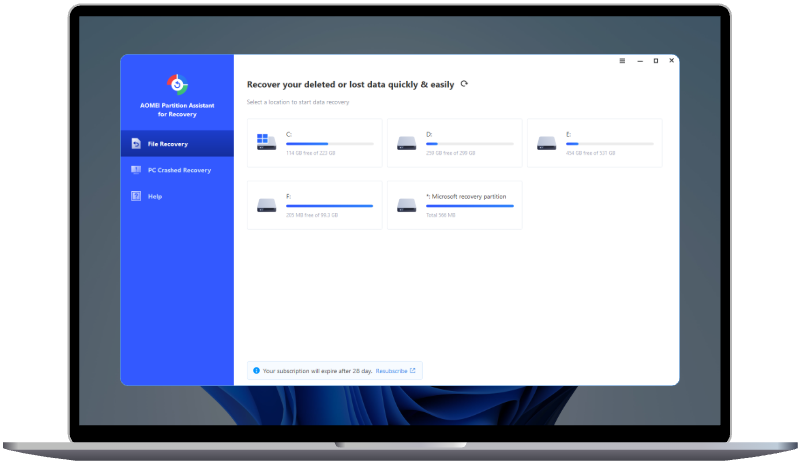[Answered] Does Unlinking Onedrive Delete Files?
Does unlinking OneDrive delete files? If not, why you can’t find OneDrive files? Check this post to know the explanations and learn to recover lost OneDrive files quickly and easily.
Does unlinking OneDrive delete files?
Unlinking OneDrive refers to disconnecting your device from your OneDrive account. When you unlink OneDrive, your computer stops syncing files with the cloud. This action is typically taken when you no longer want your files to sync or if you’re troubleshooting issues with OneDrive.
Does unlinking OneDrive delete files? Unlinking OneDrive does not delete files from your computer or from the OneDrive cloud storage. However, it stops the synchronization process, meaning any changes made on your computer won’t be updated in the cloud and vice versa. Here’s a detailed look at what happens:
♦ Files on your computer: Files remain on your computer in their current state. However, they may no longer be updated automatically with changes made in the cloud.
♦ Files in the cloud: Files stored on OneDrive remain in the cloud and can be accessed via the OneDrive website or other synced devices.
Although unlinking OneDrive doesn’t delete files, many users complain that they find their local OneDrive files missing for no reasons after disconnecting. If you have the same worry, be calm, let’s move on to the next part to help you recover lost files from OneDrive.
How to recover lost OneDrive files - 5 Methods
There are several effective methods to help you recover missing files. Before attempting any recovery, it's wise to first verify if your files are still accessible online.
>>Go to OneDrive.com, log in to your account, and see if your files are available.
If the files are not there, try the following methods:
Method 1. Check if you logged into a wrong account
Sometimes, users with multiple accounts accidentally log into the wrong one, causing files to appear missing. Your files might be stored in another account.
>> Click on the Account Manager button, select "Sign in with a different account", log into your other accounts, and check for the missing files.
Method 2. See if the owner removed the shared files/folders
Access to shared files and folders depends on the owner's permissions. If the owner removes your access or deletes the shared folder, it will no longer be available to you.
>> Reach out to the owner and request that they re-share the files or add you back to the folder.
Method 3. Search in OneDrive.com to target the lost files
If you’re unable to access the OneDrive desktop version, try searching directly on OneDrive.com. This will help determine if the files are truly missing.
>> Log in to your OneDrive account, enter the filename or file extension if you remember it, and use the search filters like Type or Date to narrow down the results.
Method 4. Look into the recycle bin on the website
Accidental deletions are a common cause of data loss, and sometimes files can be removed without your direct action. Many Dropbox users have experienced issues with automatic file deletions, and OneDrive can have similar problems, especially if you remain logged in across multiple devices.
To recover deleted files from the OneDrive Recycle Bin:
Note: The Recycle Bin retains deleted OneDrive files for 30 days.
Step 1. Go to the OneDrive website, sign in, click the menu button, and select "Recycle Bin".
Step 2. Find the deleted files, select them, and click "Restore" to recover them.
Method 5. Recover lost OneDrive files after permanent deletion
Files in the OneDrive Recycle Bin are only retained for 30 days. If your files are not in the Recycle Bin, they may have been permanently deleted.
Recovering permanently deleted files from OneDrive can be challenging for the average user. To simplify this process, consider using a reliable Windows data recovery tool. One such tool is AOMEI Partition Assistant for Recovery, which utilizes advanced scanning technology to retrieve deleted and missing files with a high success rate in just three simple steps.
AOMEI Partition Assistant for Recovery: Effortless OneDrive File Recovery
• Works in all scenarios: accidental deletion, formatting, emptied Recycle Bin, viruses, and more.
• Supports data recovery from internal and external drives, including HDDs, SSDs, SD cards, and USB devices.
• Offers filtering, previewing, and recovery options during the scanning process.
• Preserves the original filename, format, and directory structure of recovered files.
• Compatible with Windows 11, 10, 8, 7, and Server versions.
Step 1. Install and launch AOMEI Partition Assistant for Recovery. Choose the exact partition or disk where your data lost and click Scan.
Step 2. Then, the recovery tool starts to scan and search. lt will execute the “Quickly Scan" first to find your deleted data fast, and then execute the “Deep Scan" for searching other lost data.
Step 3. Once the scan is completed, all deleted files, recycle bins and other missing files will be displayed. Please select the file you would like to recover and then click "Recover".
Step 4. Then, select a folder path to save your recovered files.
Step 5. Wait patiently for this process of recovery to end.
Conclusion
If you’re wondering whether unlinking OneDrive deletes your files, the short answer is no. However, if you notice missing files after unlinking, the issue could be due to other factors, such as logging into a different account, losing access to a shared folder, or accidental deletion.
This guide will help you troubleshoot these issues and quickly restore lost OneDrive files. For efficient recovery of deleted or missing files, consider using a reliable data recovery tool like AOMEI Partition Assistant for Recovery. It’s especially useful for retrieving OneDrive files that have gone missing after syncing. Start with the free version and recover up to 100MB of data at no cost.

